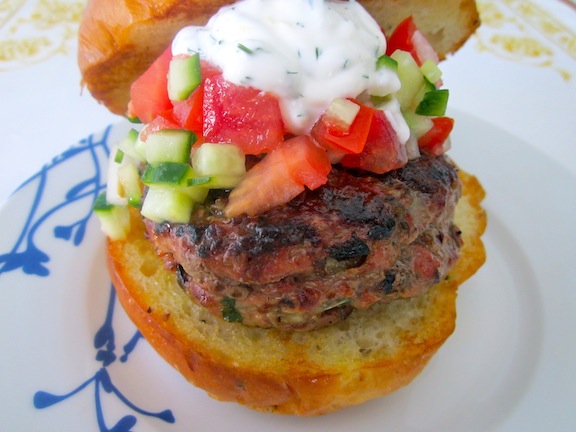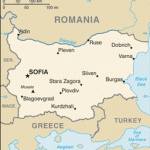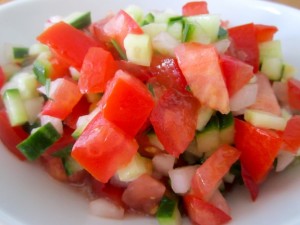 Feta stuffed burger with cucumber and tomato salsa and dill yoghurt
Feta stuffed burger with cucumber and tomato salsa and dill yoghurt
Our next stop is Bulgaria. Funny thing about Bulgaria, I kept picturing a dark dreary, somewhat scary place – picture vampires dwelling in large spooky castles. I also figured the food would be heavy and along the lines of Eastern European styles. I couldn’t have been more wrong. I forgot that Bulgaria is actually not far from the Mediterranean; it’s bordered by Turkey, Greece, Macedonia, Serbia and Romania, and enjoys a large coastal area along the Black Sea.
The coast is gorgeous, with clear blue water and big sandy beaches; we’re going to have to add this to the list of places to visit some day.
But what about the food? Oh, the food… First off Bulgarians like lots of bread – I found many different traditional bread recipes in my searches. In fact, I found so many different “classic Bulgarian bread” recipes that I decided there just wasn’t one particular bread that I needed to bake to make this recipe authentic. I also just wasn’t in the mood to bake (it’s been kind of hot here lately). So I decided a nice soft brioche roll from my local Whole Foods would work fine. The flavors of Bulgaria are similar to Greek flavors, but there is one big difference. Bulgarians and Greeks both use a lot of feta, but Greek feta is typically made from cow’s milk, while Bulgarian feta is made from goat or sheep’s milk. Luckily my local store had both and I could do a side by side tasting – the Bulgarian style tasted more like goat chevre, while the Greek style was saltier and drier.
Bulgarians also enjoy their meats, most commonly pork and lamb, but some beef also. Veal seems to be a little more common than beef and I read somewhere that this is because cows are usually used for dairy and veal is kind of a by-product of the dairy industry. I decided to forgo the veal however as I’m just not able to get past the issues surrounding veal. One of the fun thing about Bulgarians is that they like to mix up their meats – combining different types and also putting lots of flavoring into the meat itself. I know the purists won’t like this, but it makes a nice change from a standard plain burger. Another fun thing is that they like to stuff meat in Bulgaria. I meant to try stuffing a burger with a hard boiled egg, but in the chaos of three different meat combos, I forgot all about the egg.
Every now and then I lose my mind and decide that burger night would make for a good dinner party. This was one of those times. We invited over two of our closest friends to help choose the best Bulgarian burger recipe. I tried three different meat combinations (beef and lamb, lamb and pork, and beef and pork). I also tried two different topping options. My goal was to incorporate a traditional salad with the burger. Salad in Bulgaria doesn’t involve lettuce; the basic tomato and cucumber combo is one of the most common. We tried just pickling the cucumbers (sliced super thin) in oil and vinegar and serving that with sliced tomatoes. In the end, it wasn’t as good as the salsa version – you just got more bang for the buck with the salsa. So, we had six burgers, each different for six people and had to share. Luckily the stuffed burgers are half pound, so there was plenty to go around and everyone had a blast. Hectic and crazy tasting, writing notes and keeping the different options straight, but good food and wine combines so well with good friends, it was worth the chaos.
The burgers are chock full of flavor and stuffing the cheese in the middle helps get you cheese with every bite (feta is usually so crumbly, it falls off the top, so it’s a perfect stuffing cheese). I used the Williams Sonoma burger stuffing device and it is a big help and makes a nicely shaped burger. I wish it were made of metal instead of plastic, but otherwise it’s pretty awesome. If you use a device like this, just make sure to squeeze tight to seal the burgers and take the excess meat off the sides, you can make a slider or two with the meat that extrudes from the sides. I’ve tried stuffing burgers without the device and the problem I always have is getting a good seal. I’d love to hear if any of you have the secret to doing this by hand.
We served our burgers with an inexpensive cabernet. We couldn’t find a Bulgarian cab (apparently they make a lot of inexpensive cab that is surprising a good value for the price), so we did our best with local cheap but pretty good wine. Columbia Crest Cabernet is an old standby, and while I don’t usually go so cheap with company, we were trying to be authentic (we opened a fancier wine for bottle number two). Everyone enjoyed the burgers, even my dad. The only problem we had was getting them as well done as dad likes because they were so thick. The choice of lamb and pork combo was unanimous as was the salsa. So, invite some friends over and indulge in a tasty Bulgarian burger, and let me know how it goes!
If you like this burger, give the Bosnian burger a try, it also has the yummy freshness of bright ingredients.
Bulgarian Burger
1 pound ground lamb
1 pound ground pork
1 Vidalia onion minced
2 Tablespoons fresh mint chopped
2 Tablespoons fresh Italian parsley chopped
½ teaspoon dried oregano
1 teaspoon kosher salt
4 ounces goat’s milk feta sliced
4 brioche buns
Olive oil
Shopska Salad (recipe below)
Dill Yoghurt Sauce (recipe below)
In a large bowl combine all ingredients except the cheese until well mixed. Divide the mixture into 8 quarter pound patties. Using flatten each patty then create a concave well in each patty. Place sliced feta on four of the patties in the well, then top each of those patties with the remaining four patties. Seal the edges.
Grill outdoors on a charcoal grill until cooked to desired temperature.
In the meantime, slice the brioche buns and brush each side with olive oil. Grill the buns and set aside until burgers are ready.
Placed the cooked burgers on the toasted buns, serve with Shopska Salad and Dill Yoghurt Sauce on top.
Shopska Salad
½ cup Vidalia onion diced
2 medium tomatoes diced (approximately 1 cup)
1 cup English cucumber diced
1½ Tablespoons sunflower oil (you can substitute peanut or vegetable oil)
1 Tablespoon champagne vinegar (you can use white wine vinegar)
Pinch of salt
1 Tablespoon fresh Italian parsley chopped
Combine first three ingredients in a medium bowl. In a small bowl whisk the remaining ingredients, taste and correct seasoning. Combine the dressing with the vegetables and let sit at room temperature for at least 20 minutes before using. If Vidalia’s aren’t in season, you can use regular white or yellow onions, but I recommend soaking them in ice cold water for about ten minutes before adding to the other ingredients – this takes some of the sting out of the onions and makes them more pleasant and less aggressive.
Dill Yoghurt Sauce
6 ounces Greek yoghurt
2 Tablespoons finely chopped fresh dill
½ teaspoon lemon zest
Pinch of kosher salt
Mix all ingredients together in a small bowl and refrigerate until ready to use.
©Copyright 2011 Linda Monach





Nice writing style. I look forward to reading more in the future.
Hey 🙂 Greetings from Bulgaria! I’m so happy our country finally made it to your blog 🙂 I follow your blog and I’m always happy to see a new recipe, but I was even happier when I saw the bulgarian one 🙂 Actually most of the things you said about our eating and cooking habits are true. But here burgers are viewed as junk food and people rarely make them at their homes. And one more thing – this is not quite how we make shopska salad – we also add green pepper and onion and when it’s all ready we grate some feta on top. Sometimes we add an olive or two, but it’s not obligatory 🙂 It makes a huge difference if you prepare the salad in this way 🙂
Have a nice day!
Thanks Nora! I’m glad I got it mostly right. I purposefully left out the green pepper and onion because I don’t really like raw onion or green peppers (raw or cooked). This is why I don’t claim that my recipes are authentic – that allows me flexibility to make stuff I like :).
Most countries seem to look down upon our friend the burger – such a shame, perhaps we need to start a movement to get burger respect around the world 🙂
Thanks for your comments and for following the blog
This looks delicious! It will be on the menu tonight if I get my act together and get to the store, or over the weekend. Lots of fresh flavors!
Thanks Nerida. I hope you like it half as much as I liked your carmalized onion and goat cheese pizza – that was awesome!
Just a quick clarification – I think you’ve mixed up the Bulgarian and Greek feta. I admit that I have never actually tasted Greek feta, but being a Bulgarian I’m pretty sure that we use almost exclusively cow’s milk for ours. Also the wikipedia page on Feta says the same – “Since 2002, feta has been a protected designation of origin product. According to the relevant EU legislation, only those cheeses produced in a traditional way in some areas of Greece (mainland and the island of Lesbos), and made from sheep milk, or from a mixture of sheep and goats’ milk (up to 30%) of the same area, may bear the name “feta”.”
And the “Bulgarian feta” is also called
Thanks for your comment Miroslav. Unfortunately or fortunately, I live in the US and here Feta is considered a generic term, we don’t follow the EU rules regarding the use of the name. I stand by my statement the Bulgarian Feta is made from sheep and cow’s milk, just Google “Bulgarian Feta” and you’ll find a ton of references. Where I went wrong was in thinking Greek Feta was a cow’s milk cheese. As you point out, it is definitely not made from cow’s milk, but is also a sheep/goat milk cheese. Interestingly though, in the US, most of the Feta that we find in our typical grocery store is made from cow’s milk (I have a lactose intolerant friend who despairs of this regularly). The cow’s milk version has a much different flavor, but it is what most Americans think of as Feta cheese.
Thanks for writing in and getting me to dig into this further – the story of cheese around the world is fascinating. And, as a final note and to finish where you left off, Bulgarian Feta is called Sirene (since only the Greeks can use the name Feta in the EU). I haven’t found actual Sirene in my local shops, but now I am determined to search it out – if you know a good cheese shop in Boston, let me know!
Made the Bulgarian Burgers for dinner last night. We loved the flavors and the feta in the middle.
So glad you enjoyed the burgers Nerida – I’m hoping for a good excuse to use your drunken onions on a burger – maybe for France?!